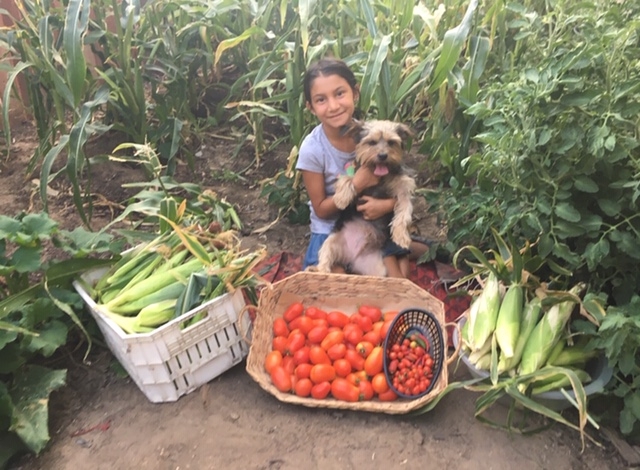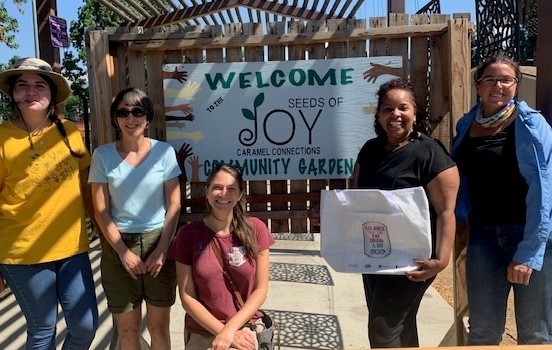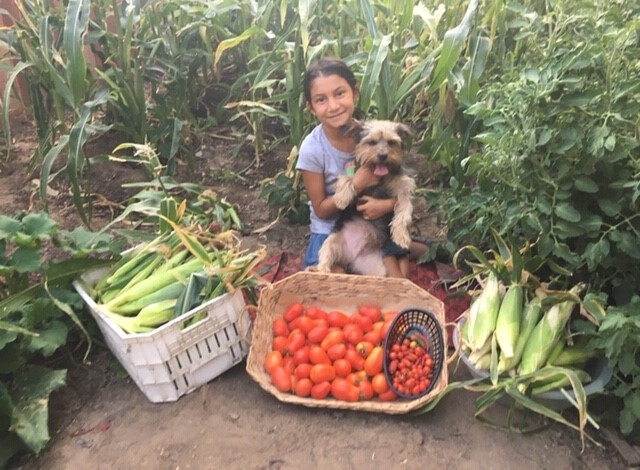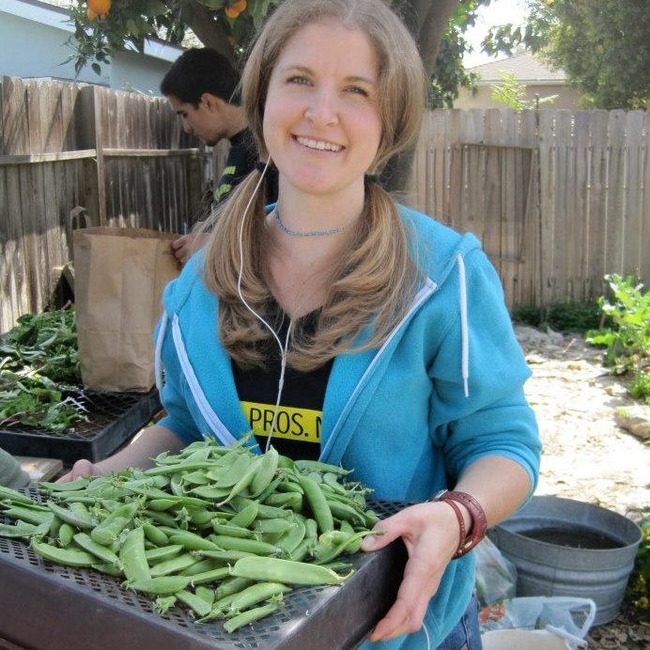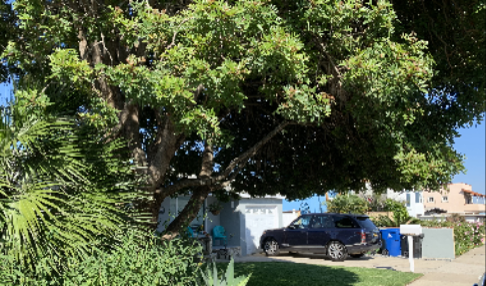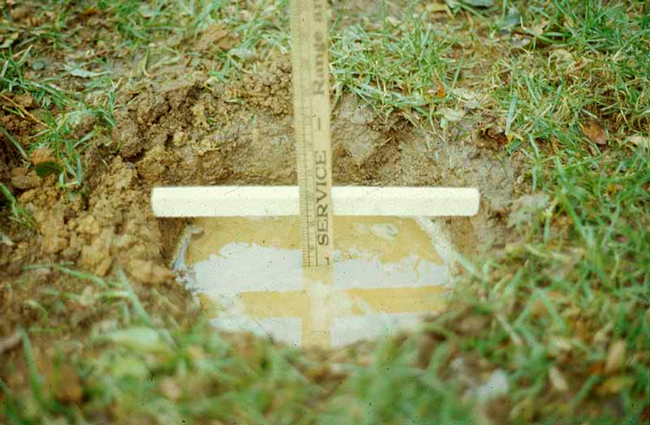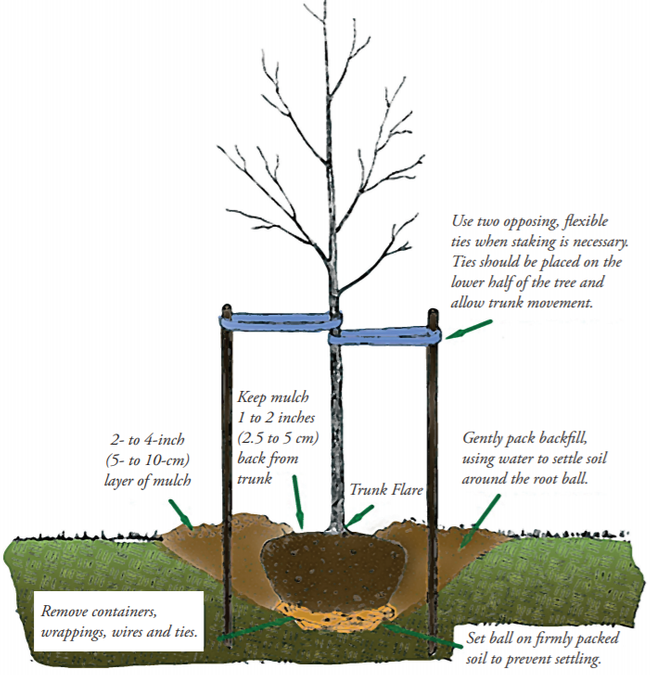Posts Tagged: benefits
Benefits of Plants to People, Communities, and Urban Urban Ecosystems: Part 1
Benefits of Plants to People, Communities and Urban Ecosystems: Part 1:
The link between horticulture and health and well-being and to urban ecosystems has been scientifically documented for centuries. In 1812, psychiatrist, professor, and Declaration of Independence signer Dr. Benjamin Rush reported in his book “Medical Inquiries and Observations, Upon the Diseases of the Mind” (Rush 1812) that patients “digging in the dirt”
fared better than their non-gardener counterparts. Since then, hundreds of scientific studies have been published documenting benefits of active (e.g. gardening/landscaping) and passive (e.g. viewing nature through a window, taking a walk in a park) interactions between people and plants and the value of plants in urban ecosystems.Benefits related to cognitive functioning, societal and community health, and mental health are summarized below. Ecosystem and physical health benefits from interacting with nature will be discussed in next month's blog.
Improved Cognitive Functioning
Several studies link participation in gardening activities to enhanced cognitive functioning (Bratman et al. 2012; Dadvand et al. 2015; Kuo et al. 2021; Ohly et al. 2016; Park et al. 2019; Stevenson et al. 2018; Wells 2000. Research conducted by Kuo and Sullivan (2001) and Mayer et al. (2009) found that exposure to nature in urban settings can enhance attention span, working memory, and concentration. Both youth and adults who participate in greening and gardening projects were also found to have higher cognitive functioning in the areas of short and long term memory, focus and concentration (Dadvand et al. 2015; Markevych et al. 2019; Matsuoka 2010; Meuwese et al. 2021; Park et al. 2019; Stevenson et al. 2018) and reduced symptoms of ADHD (Faber Taylor and Kuo (2011).
Other studies summarized in a literature review (Williams and Dixon 2013) found that kindergarten and middle school students who participated in school gardening activities linked to classroom learning in biology, nutrition, mathematics, and other subjects earned higher grades and attained greater academic achievement than non-participants. A recent study linked high tree canopy coverage on school grounds with higher achievement scores in math and reading in middle school students across a wide range of socioeconomic and ethnic backgrounds (Kuo et al. 2021). The experiential (hands-on) learning elements of school gardens can also bridge the gap between traditional and non-traditional learners due to its multi-sensory nature (Kolb and Kolb 2005). School gardens play an especially important academic role among elementary-aged youth from low-wealth inner city communities exposed to outdoor experiential learning that was previously lacking (Dyg et al. 2020; Kuo et al. 2021; Ray et al. 2016; Williams et al. 2013). However, Hoover et al. (2021) found that successful, sustainable school gardens require strong administrative and district support in addition to enthusiasm and support from parents and teachers.
Enhancement of Societal and Community Health
Urban greening projects that remediate vacant land, landscape streets and neighborhoods, create community gardens, and improve the health of wetlands and undeveloped natural environments can build community cohesiveness, neighborhood bonding, and mutual community pride (Diamant and Waterhouse 2010; Draper 2010; Glover et al. 2005; Hartwig and Mason 2016; Kuo and Sullivan 2001; Moyer et al. 2019; Neo and Chua 2017; Saldivar-Tanaka and Krasny 2004). With blighted uncared-for vacant lots comprising nearly 15% of total land area of U.S. cities (Branas et al. 2018) these opportunities are substantial. Results also indicate that gardening and urban greening projects unite people from different cultural and ethnic backgrounds who enjoy growing and sharing produce from their native regions (Agustina and Beilin 2012; Baker 2004; Cruz-Piedrahita et al. 2020; Dyg et al. 2016; Hartwig and Mason 2016; Teig 2009). Building a sense of community through social engagement, celebrations, and communal meals has also been found to benefit both gardeners and non-gardener participants (Ober et al. 2008).
Well-designed and maintained urban green spaces not only bring people together, but can reduce crime, gun violence and enhance the safety and cohesiveness of urban neighborhoods, as summarized in several literature reviews (Bogar and Byer 2016: Mancus and Campbell 2018; Shepley et al. 2019). Some of the strongest links reported in the literature involve crime reduction in vegetated and well maintained urban neighborhoods and walkways (Branas et al. 2018; Demotto 2006; Garvin et al. 2013; Locke et al. 2017) and a reduction in gun violence in neighborhoods with green spaces including trees (Branas et al. 2018; Kondo 2017; Schertz et al. 2021; Wolfe et al. 2012). One study found that community-based greening projects that vegetated vacant lots was an effective strategy to improve neighborhood safety, resulting in a nearly 40% decrease in violent crime (Heinze et al. 2018). It should be noted that other researchers (Groff and McCord 2012) found a higher incidence of opportunistic crime in high tree canopy covered areas, perhaps due to concealed illegal activities. Another study found that actively participating in community greening projects from design through implementation and maintenance can result in a sense of accomplishment and satisfaction (Murphy-Dunning 2009). Neighbors caring for urban green spaces together also tend to spend more time conversing and building important social relationships than do non-participants (Peters et al. 2010).
Improved Mental Health
Multiple literature reviews link interactions with nature to improved mental health in both youth and adults (Bowler et al. 2010; Clatworthy et al. 2013; Coventry et al. 2021; Cruz-Piedrahita et. al. 2020; De Vries et al. 2003; Tillmann et al. 2018) in studies conducted in parks, gardens, urban green spaces, and even shopping malls. The restorative impact of simply viewing plants has also been widely studied. Walking through a park and even viewing a natural scene through a window can lead to a sense of well-being, restfulness, reflection, and reduced mental fatigue (Shanahan et al. 2019). More recently, Dzhambov et al. (2020) found lower rates of depression in students homebound for long periods of time during the COVID-19 pandemic with views of plants (indoors and out) compared to students who lacked plant interactions. Bowler's (2010) literature review also highlighted strong associations for self-reported positive emotions and lower levels of anger and sadness in natural settings compared to non-natural settings. Interactions with nature can also reduce symptoms of depression and anxiety (Beyer et al. 2014; Gonzalez et al. 2010; Lee and Maheswaran 2011; Van den Berg and Custers 2011; Wilson and Christensen (2011).
Thompson Coon et al. (2011) reported that exercising outdoors in natural settings led to greater feelings of positivity and revitalization, less tension, anger, and depression compared to the same amount of exercise indoors. Other studies link gardening to feelings of peace and contentment (Meuwese et al. 2021; Shanahan et al. 2015; Shanahan et al. 2019). MacKerron and Mourato (2013) reported that individuals who interact with nature are often happier than those lacking this interaction and Ambrose et al. (2020) reported that home gardeners growing food crops experienced particularly high levels of happiness and meaningfulness. Bakolis et al. (2018) linked two elements of mental well-being (optimism and energy) to interactions with nature while Van den Berg and Clusters (2011) and Wood et al. (2016) found a link between engagement with nature and a reduction in stress. While White et al. (2019) determined that these benefits are maximized when individuals spend 120 minutes a week or more interacting with nature, shorter periods of exposure are also beneficial (Shanahan et al. 2016; Shanahan et al. 2019; White et al. 2019).
Other studies reported a link between growing food and a deepened sense of purpose (Tzoulas 2007; Wiesinger 2006). Digging in the soil can be a welcome distraction from busy lives laden with deadlines, traffic jams, and other everyday stressors. Focusing on the needs of plants, whether it be watering, fertilizing, harvesting or other tasks, can prove pleasantly distracting, providing time for reflection and even problem resolution (Capaldi et al. 2015; Meuwese et al. 2021; Stevenson et al. 2018). Several research papers report important positive roles that plants play related to mental health as impacts of climate change increase (Cryder et al. 2006; Dillman-Hasso et al. 2021; Doherty 2018; Fernandez et al. 2015) related to posttraumatic stress disorder (PTSD), major depressive disorder, stress, anxiety and others.
Literature Cited
Agustina I and Beilin R. 2012. Community gardens: Space for interactions and adaptations, Procedia - Social and Behavioral Sciences. 36:439-448. https://doi.org/10.1016/j.sbspro.2012.03.048
Ambrose G, Das K, Fan Y, Ramaswami A. 2020. Is gardening associated with greater happiness of urban residents? A multi-activity, dynamic assessment in the Twin-Cities region, USA, Landscape and Urban Planning,198(2020). https://doi.org/10.1016/j.landurbplan.2020.103776
Baker LE. 2004. Tending cultural landscapes and food citizenship in Toronto's community gardens. Geographical Review, 94(3):305-325. https://doi.org/10.1111/j.1931-0846.2004.tb00175.x
Bakolis I, Hammoud, R, Smythe, M, et al. 2018. Using Smartphone Technologies to Investigate the Impact of Nature on Mental Well-Being in Real Time, BioScience. 68:134–145, https://doi.org/10.1093/biosci/bix149
Beyer KM, Kaltenbach A, Szabo A, et al. 2014. Exposure to neighborhood green space and mental health: evidence from the survey of the health of Wisconsin. Int. J. Environ. Res. Public Health. 11:3453-3472. https://doi.org:10.3390/ijerph110303453
Bogar S. and Beyer K. 2016. Green space, violence, and crime: a systematic review. Trauma, Violence, & Abuse 17(2)160-171. Accessed Sept. 28, 2021 from: http://journals.sagepub.com.proxyau.wrlc.org/doi/pdf/10.1177/1524838015576412
Bowler DE, Buyung-Ali, L, Knight TM, Pullin AS. 2010. Urban greening to cool towns and cities, A systematic review of the empirical evidence. Landscape and Urban Planning, 97(3):147–155. https://doi.org/10.1186/1471-2458-10-456
Branas C, South E, Kondo M, Hohl B, Bourgois P, Wiebe D, MacDonald J. 2018. Citywide cluster randomized trial to restore blighted vacant land and its effects on violence, crime, and fear. Proceedings of the National Academy of Sciences of the United States of America. http://www.pnas.org/content/early/2018/02/20/1718503115
Bratman GN, Hamilton JP, Daily GC. 2012. The impacts of nature experience on human cognitive function and mental health. Ann. N. Y. Acad. Sci. 1249:118–136. https://doi.org:10.1111/j.1749-6632.2011.06400.x
Capaldi CA, Passmore H, Nisbet EK, Zelenski JM, Dopko RL. 2015. Flourishing in nature: A review of the benefits of connecting with nature and its application as a wellbeing intervention. International Journal of Wellbeing, 5(4):1-16. https://doi.org:10.5502/ijw.v5i4.1
Clatworthy J, Hinds J, Camic P. 2013. Gardening as a mental health intervention: a review. Mental Health Review. 18 (4):214-225. https://doi.org:10.1108/MHRJ-02-2013-0007
Coventry PA, Jennifer VE, Brown J, et al. 2021. Nature-based outdoor activities for mental and physical health: Systematic review and meta-analysis. Popul Health.1;16:100934. https://doi.org/10.1016/j.ssmph.2021.100934
Cruz-Piedrahita C, Howe C, de Nazelle A. 2020. Public health benefits from urban horticulture in the global north: A scoping review and framework, Global Transitions 2:246-256 https://doi.org/10.1016/j.glt.2020.10.001
Cryder CH, Kilmer RP, Tedeschi RG, Calhoun LG. 2006. An exploratory study of posttraumatic growth in children following a natural disaster. Am J Orthopsychiatry 76(1):65–69. https://doi.org:doi:10.1037/0002-9432.76.1.65
Dadvand P, Nieuwenhuijsen, MJ, Esnaola M, et al. 2015. Green spaces and cognitive development in primary schoolchildren. Proceedings of the National Academy of Sciences of the United States of America, 112(26):7937–7942. https://doi.org/10.1073/pnas.1503402112
Demotto N, and Davies CP. 2006. A GIS analysis of the relationship between criminal offenses and parks in Kansas City, Kansas. Cartogr. Geogr. Inf. Sci.33:141-157. https://doi.org/10.1559/152304006777681715
De Vries S, Verheij RA, Groenewegen PP, Spreeuwenberg P. 2003. Natural environments-healthy environments? An exploratory analysis of the relationship between greenspace and health. Environment and planning. 35(10):1717–1731. https://doi.org/10.1068/a35111
Diamant E and Waterhouse A. 2010. Gardening and belonging: reflections on how social and therapeutic horticulture may facilitate health, wellbeing and inclusion. Br J Occup Ther.73:84-88. https:doi.org: https://doi.org/10.4276/030802210X12658062793924
Dillman-Hasso N. 2021. The nature buffer: the missing link in climate change and mental health research. J Environ Stud Sci. https://doi.org/10.1007/s13412-021-00669-2
Doherty TJ. 2018. Individual impacts and resilience. In: Clayton S, Manning C (eds) Psychology and Climate Change. Academic Press, pp 245–266. https://doi.org/10.1016/B978-0-12-813130-5.00010-2
Draper C and Freedman D. 2010. Review and Analysis of the Benefits, Purposes, and Motivations Associated with Community Gardening in the United States, Journal of Community Practice. 8(4):458-492. https://doi:10.1080/10705422.2010.519682
Dzhambov AM, Lercher P, Browning MH, et al. 2020. Does greenery experienced indoors and outdoors provide an escape and support mental health during the COVID-19 quarantine? Environmental Research, 110420. https://doi.org/10.1016/j.envres.2020.110420
Dyg P, Christensen S, Peterson C. 2020. Community gardens and wellbeing amongst vulnerable populations: a thematic review, Health Promotion International, Volume 35, Issue 4, August 2020, Pages 790–803, https://doi.org/10.1093/heapro/daz067
Faber Taylor A and Kuo FE. 2011. Could exposure to everyday green spaces help treat ADHD? Evidence from children's play settings. Applied Psychology: Health and Well-Being, 3: 281-303. https://doi.org/10.1111/j.1758-0854.2011.01052.x
Fernandez A, Black J, Jones M, Wilson L, Salvador-Carulla L, Astell-Burt T, Black D. 2015. Flooding and mental health: a systematic mapping review. PLoS One https://doi.org:10(4):e0119929
Garvin EC, Cannuscio CC, Branas CC. 2013. Greening vacant lots to reduce violent crime: A randomised controlled trial. Inj Prev. 19:198–203. https://doi.org:10.1136/injuryprev-2012-040439
Glover TD, Shinew KJ, Parry DC. 2005. Association, sociability, and civic culture: the democratic effect of community gardening. Leis Sci. 2005;27(1):75–92. https://doi.org:10.1080/01490400590886060
Gonzalez MT, Hartig T, Patil GG, Martinsen EW, Kirkevold M. 2010. Therapeutic horticulture in clinical depression: a prospective study of active components. J Adv Nurs. 66:2002-2013. https://doi.org:10.1891/1541-6577.23.4.312
Groff, E and McCord ES. 2012. The role of neighborhood parks as crime generators. Secur. J. 25:1–24, https://doi.org:10.1057/SJ.2011.1
Hartwig, KA and Mason M. 2016. Gardens for refugee and immigrant communities as a means of health promotion. J. Community Health, 41 (6):1153-1159. https://doi.org/10.1007/s10900-016-0195-5
Heinze JE, Krusky-Morey A, Vagi KJ, Reischl TM Franzen S, Pruett NK, Cunningham RM, Zimmerman MA. 2018. Busy streets theory: the effects of community-engaged greening on violence. American journal of community psychology, 62(1-2):101–109. https://doi.org/10.1002/ajcp.12270
Hoover, Amy, Vandyousefi Sarvenaz, Martin Bonnie, et al. 2021. Barriers, Strategies, and Resources to Thriving School Gardens, J Nutr Educ Behav. 53(7):591-601. https://doi.org/10.1016.j.jneb.2021.02.011
Kolb DA and Kolb AY. 2005. Learning styles and learning spaces: Enhancing experiential learning in higher education, Academy of Management Learning and Education, 4(2):193-212. Accessed Sept. 16 2021: http://www.jstor.org/stable/40214287.
Kondo MC, South EC, Branas CC, Richmond TS, Wiebe D.J. 2017. The association between urban tree cover and gun assault: a case-control and case-crossover study. American Journal of Epidemiology 186(3):289-296. https://doi.org:10.1093/aje/kwx096
Kuo M, Klein SE, Browning MH, Zaplatosch J. 2021. Greening for academic achievement: Prioritizing what to plant and where, Landscape and Urban planning, 206(2021). https://doi.org/10.1016/j.landurbplan.2020.103962
Kuo F.E.; Sullivan W.C. 2001. Environment and Crime in the Inner City—Does Vegetation Reduce Crime? Environ. Behav. 33(343). https://doi.org:10.1177/0013916501333002
Lee, ACK and Maheswaran, R. 2011. The health benefits of urban green spaces: a review of the evidence. Journal of Public Health, 33(2), 212-222. https://doi.org/10.1093/pubmed/fdq068
Locke DH, Han S, Kondo MC, Murphy-Dunning C, Cox M. 2017. Did community greening reduce crime? Evidence from New Haven, CT, 1996–2007. Landsc. Urban Plan. 2017;161:72–79. https://doi.org:10.1016/j.landurbplan.2017.01.006
MacKerron G and Mourato S. 2013. Happiness is greater in natural environments. Global Environmental Change. 23(5):992-1000. https://doi.org/10.1016/j.gloenvcha.2013.03.010
Mancus GC and Campbell J. 2018. Integrative review of the intersection of green space and neighborhood violence. J. Nurs. Scholarsh. 50:117–125. https://doi.org:10.1111/jnu.12365
Markevych, I. Feng, X. Astell-Burt T. Standl M. Sugiri D. Schikowski, et al. 2019. Residential and school greenspace and academic performance: Evidence from the GINIplus and LISA longitudinal studies of German adolescents. Environ. Pollut. 245:71-76. https://doi.org/10.1016/j.envpol.2018.10.053
Matsuoka RH. 2010. Student performance and high school landscapes: Examining the links. Landsc. Urban Plan. 97:273-282. https://doi.org/10.1016/j.landurbplan.2010.06.011
Mayer FS, Frantz CM, Bruehlman-Senecal E, Dolliver K. 2009. Why Is Nature Beneficial? The Role of Connectedness to Nature. Environment and Behavior.41(5):607-643. https://doi.org:10.1177/0013916508319745
Meuwese D, Maas J, Krabbendam L, Dijkstra K. 2021. Viewing Nature Lets Your Mind Run Free: Three Experiments about the Influence of Viewing a Nature Video on Cognitive Coping with Psychological Distress. Int J Environ Res Public Health. 22;18(16):8842. https://doi.org:10.3390/ijerph18168842
Moyer R, MacDonald JM, Ridgeway G, Branas CC. 2019. Effect of remediating blighted vacant land on shootings: a citywide cluster randomized trial. Am. J. Public Health.109:140–144. https://doi.org/10.2105/AJPH.2018.304752
Neo H and Chua CY. 2017. Beyond inclusion and exclusion: community gardens as spaces of responsibility. Ann. Am. Assoc. Geogr. 107(3):666-681. https://doi.org:10.1080/24694452.2016.1261687
Ober J, et al. 2008. Growing vegetables and values: benefits of neighborhood-based community gardens for youth development and nutrition, Journal of Hunger & Environmental Nutrition 3(4):418-439, https://doi.org:10.1080/19320240802529169
Ohly H, White MP, Wheeler BW, et al. 2016. Attention restoration theory: A systematic review of the attention restoration potential of exposure to natural environments. Journal of Toxicology and Environmental Health, Part B, 19 (7):305-343, https://doi.org:10.1080/10937404.2016.1196155
Park, SA, Lee AY, Park H, Lee WL. 2019. Benefits of Gardening Activities for Cognitive Function According to Measurement of Brain Nerve Growth Factor Levels. International journal of environmental research and public health, 16(5):760. https://doi.org/10.3390/ijerph16050760
Ray R, Fisher DR, Fisher-Maltese C. 2016. School gardens in the city. Does environmental equity help close the achievement gap?. Du Bois Review: Social Science Research on Race, 13(2):379-395. Accessed Sept. 15, 2021 from: http://dx.doi.org/10.1017/S1742058X16000229
Rush B. Medical inquiries and observations upon diseases of the mind. Philadelphia: Kimber & Richardson; 1812. [Accessed August 28, 2010]. p. 226. Available at: http://deila.dickinson.edu/theirownwords/title/0034.htm
Saldivar-Tanaka L and Krasny ME. 2004. Culturing community development, neighborhood open space, and civic agriculture: the case of Latino community gardens in New York City. Agric. Hum. Val., 21 (4):399-412. https://doi.org/10.1023/B:AHUM.0000047207.57128.a5
Schertz KE, Saxon J, Cardenas-Iniguez C, et al. 2021. Neighborhood street activity and greenspace usage uniquely contribute to predicting crime. npj Urban Sustain.1(19). https://doi.org/10.1038/s42949-020-00005-7
Shanahan DF, Astell-Burt T, Barber EA, Brymer E, et al. 2019. Nature-based interventions for improving health and wellbeing: the purpose, the people and the outcomes. Sports (Basel)10;7(6):141. http://doi.org:10.3390/sports7060141
Shanahan DF, Fuller RA, Bush R, Lin BB, Gaston KJ. 2015. The health benefits of urban nature: how much do we need? BioScience 65(5):476–485. https://doi.org/10.1093/biosci/biv032
Shepley M, Sachs N, Sadatsafavi H, Fournier C, Peditto K. 2019. The impact of green space on violent crime in urban environments: An evidence synthesis. Int. J Environ Res Public Health. 2019;16(24):5119. https://doi.org:10.3390/ijerph16245119
Stevenson MP, Schilhab T, Bentsen P. 2018. Attention restoration theory II: A systematic review to clarify attention processes affected by exposure to natural environments Journal of Toxicology and Environmental Health, Part B, 21(4):227-268. https://doi.org:10.1080/10937404.2018.1505571
Teig E, Amulya J, Bardwell L, et al. 2009. Collective efficacy in Denver, Colorado: Strengthening neighborhoods and health through community gardens. Health & Place, 15(4): 1115-1122. https://doi.org/10.1016/j.healthplace.2009.06.003
Thompson Coon J, Boddy K, Stein R, et al. 2011. Does participating in physical activity in outdoor natural environments have a greater effect on physical and mental wellbeing than physical activity indoors? A systematic review. https://doi.org:10.1021/es102947t
Tillmann S, Tobin D, Avison W, Gilliland J. 2018. Mental health benefits of interactions with nature in children and teenagers: a systematic review. J Epidemiol. Community Health 72(10):958–966. https://doi.org:10.1136/jech-2018-210436
Tzoulas K, Korpela K, Venn S. 2007. Promoting ecosystem and human health in urban areas using green infrastructure: a literature review. Landsc. Urban Plan. 2007;81:167–178. https://doi.org/10.1016/j.landurbplan.2007.02.001
Van den Berg AE and Custers MH. 2011. Gardening promotes neuroendocrine and affective restoration from stress. J. Health Psychol.16:3–11https://doi.org/10.1177/1359105310365577
Wiesinger G, Neuhauser F, Putz M. 2006. Farming for health in Austrian Farms, horticultural therapy, animal-assisted therapy. In: Hassink J., Dijk M., editors. Farming for health: Green-Care farming across Europe and the United States of America. Springer; Dordrecht, The Netherlands, pp. 233–248. Wells, NM. 2000. At home with nature: Effects of “greenness” on children's cognitive functioning. Environ. Behav.32(6):775–795. https://doi.org:10.1177/00139160021972793
White MP, Alcock I, Grellier J. et al. 2019. Spending at least 120 minutes a week in nature is associated with good health and wellbeing. Sci Rep 9(7730). https://doi.org/10.1038/s41598-019-44097-3
Wilson JF and Christensen KM. 2011. The relationship between gardening and depression among individuals with disabilities. J. Ther. Hortic. 2011;21:28–41.
Williams DR, Dixon PS. 2013. Impact of Garden-Based Learning on Academic Outcomes in Schools: Synthesis of Research Between 1990 and 2010. Review of Educational Research. 2013;83(2):211-235. http://doi.org:10.3102/0034654313475824
Wolfe MK, Mennis J, Mennis J. 2012. Does vegetation encourage or suppress urban crime? Evidence from Philadelphia, PA. Landsc Urban Plan.108(2-4):112–122. https://doi.org:10.1016/j.landurplan.2012.08.006
Wood C.J., Pretty J., Griffin M. 2016. A case–control study of the health and well-being benefits of allotment gardening. J. Public Health. 38:336–e344. https://doi.org/10.1093/pubmed/fdv146
Wolch, J, Byrne, J Newell, J. 2014. Urban green space, public health, and environmental justice: The challenge of making cities `just green enough'. 125:234-244. https://doi.org10.1016/j.landurbplan.2014.01.017
Benefits of Horticulture and Human Interactions
“To forget how to dig the earth and to tend the soil is to forget ourselves.” Mohandas K. Gandhi, World leader, political ethicist, lawyer
“Everything that slows us down and forces patience, everything that sets us back into the slow circles of nature, is a help. Gardening is an instrument of grace. ” May Sarton, Poet “
"May our heart's garden of awakening bloom with hundreds of flowers.” Thich Nhat Hanh, global spiritual leader and activist “If you have a garden and a library, you have everything you need.” Marcus Tullius Cicero, Roman philosopher
"The importance of encouraging our children in outdoor work with living plants is now recognized. It benefits the health, broadens the education, and gives a valuable training in industry and thrift. The great garden movement is sweeping over all America, and our present problem is to direct it and make it most profitable to the children in our schools and homes. — Van Evrie Kilpatrick, 1918, in “The Child's Food Garden”
As the above quotes so beautifully proclaim, interacting with nature, whether passively (viewing plants) or actively (gardening, etc.) offers many positive benefits. In fact, the link between horticulture and health and well-being has been scientifically documented for centuries. In 1812, psychiatrist, professor, and Declaration of Independence signer Dr. Benjamin Rush reported that patients participating in gardening activities had better mental health outcomes than non-gardening counterparts.
Many additional papers were published throughout the 1800's documenting benefits of active participation in gardening. More recently, positive links between simply viewing plants through a window or even on a television, movie, or exercise apparatus screen have been reported in peer-review journals. A groundbreaking study in this area was published in 1984 by environmental psychologist Robert Ulrich (Ulrich, 1984) who compared post-operative patients recovering from gall bladder surgery who had views of landscape plants to recovering patients who had the same surgery in the same facility with views of a brick wall. Patients with landscape views had fewer surgical complications, shorter hospital stays, required fewer analgesics, had better moods, and even fewer derogatory remarks by medical staff in their daily records.
Since 1984, dozens of other studies have documented similar positive outcomes resulting from both passive and active engagement with nature and plants. These include improved physical, mental and emotional health; environmental benefits; and community and societal benefits. Recent literature reviews that summarize these findings include:
- An overview of 77 peer-reviewed journal articles (Howarth, et. al., 2020) identified 35 positive outcomes linking physical and mental health and well-being to active and passive horticultural interactions. doi: https://10.1136/bmjopen-2020-036923
-A meta-analysis (Soga, 2016) of 22 studies identified several positive mental health outcomes related to gardening including mood, group cohesiveness, cooperation, pride, well-being, and more. https://doi.org/10.1016/j.pmedr.2016.11.007 -
An overview of 45 peer-review studies (Shepley, et. al., 2019) identified links between properly designed and maintained urban green spaces and crime, gun violence, and the overall safety and cohesiveness of low-wealth urban neighborhoods. https://doi.org/10.3390/ijerph16245119
- A review of 120 papers (Crus-Piedrahita, et. al., 2020) reported public health benefits from urban horticulture activities in the global North. Thirty-two papers had a specific focus on social cohesion and/or social capital. https://doi:10.1016/j.glt.2020.10.001
-Alizadeh (2019) synthesized research regarding the environmental benefits of urban plants, highlighting their vital roles in combating climate change, cooling urban heat islands, providing habitat, removing air and water pollutants, enhancing soil health, and more. https://www.researchgate.net/deref/https%3A%2F%2Fdoi.org%2F10.1108%2FIJCCSM-10-2017-0179
Enjoy your garden! Enjoy a day in nature.
Plant a Tree. Leave a Legacy!
Do you have Spring Fever? If you have adequate space, why not leave a legacy to your children's children by planting a tree? When the right species is planted in the right location with the right care, landscape trees can be enjoyed for 100 years or more. Landscape trees cool urban heat islands, absorb carbon dioxide, filter toxic chemicals from soil preventing them from polluting our waterways, reduce soil and water erosion, reduce internal energy needs and related costs, provide habitat, and beautify neighborhoods.
Spring is a much better times to plant a container landscape tree in California than is summer. Trees incur far less stress if they've been in the ground several weeks rather than having to immediately adapt to high summer temperatures. Cooler weather allows plants to establish roots in their new ‘home' before the harshness of summer sets in. (Deciduous bare-root fruit trees, on the other hand, should be planted during the winter when they are dormant.) Choose recommended species for your climate and micro-climate.
Choose trees based on your Sunset climate zone (more precise than USDA zones for California since they include impacts of high temperatures as well as low temperatures) and your microclimate (shade, soil conditions, space, etc.). Four of my favorite search engines that allow one to search by multiple criteria (size, water needs, flower color, ecosystem functions, pest susceptibility, etc.) are: Inland Valley Garden Planner: https://inlandvalleygardenplanner.org/; Cal Poly, Pomona: https://selectree.calpoly.edu;California Native Plant Society: http://www.cnps.org/cnps/grownative/lists.php; and WUCOLS IV (Water Use Classification of Landscape Species): http://ucanr.edu/sites/WUCOLS
Avoid circled, girdled roots. Remember to inspect the root system of container trees. Avoid purchasing specimens with severely circled and girdled roots. Root pruning will not solve the problem and the resulting tree is much more prone to failure later. This occurs because the upper portion of the tree continues to grow and expand while the root system lacks the breadth and architectural strength to support the tree. Many times a tree will look fine for several years and - seemingly - very suddenly topple in winds that otherwise it could sustain with a more adequate root system. Only when the tree falls does the owner actually notice firsthand that the root system is the same size it was when the tree was planted years before!
Check drainage before you plant. Dig a hole where you are planning on planting the tree, fill it with water, and make sure it completely drains within 24-hours. If it doesn't drain, don't plant a tree there. In some cases, trees are carefully selected based on species and location only to perish ten or more years later due to poor drainage and water-logged soil. Trees often die in these situations due to a lack of aeration setting them up for disease-causing fungal pathogens.
Planting the tree. Dig a hole at least 2-1/2 times the width of the container (in clay or compacted soils make the hole at least 4-5 times wider) up to two inches shallower than the depth of the tree in the container to compensate for settling. Use a shovel or trowel to roughen the soil on the sides of the hole to encourage root growth into the native soil. Remove the tree from the container along with any loose soil that covers the lower part of the trunk. Carefully place the tree in the planting hole, keeping the trunk flare (the area where the trunk widens and connects with the roots) 1-2 inches above the existing grade. Gently fill the hole with the same soil that was removed. Do not add soil amendments or compost, another common cause of circled and kinked roots. Irrigate the tree immediately after planting through the entire root system and slightly deeper. Keep in mind that soils with appreciable clay content absorb water more slowly than sandier soils and need to be watered longer but less often. Water newly planted container trees often through their establishment period, even if they are drought tolerant species. Recently transplanted trees have a small volume of roots that dry out very quickly. Water newly planted trees regularly through the first season. Trees in sandy soils require more frequent watering than do trees in heavier soils. (After trees are fully established, irrigation frequency should be reduced but more water should be added during each irrigation.)
Avoid staking trees unless necessary. Stake trees only if they were staked at the nursery and/or if they are planted in a wind-prone area. Remember to loosen ties on nursery stock before they girdle the trunk. Gently secure any tree requiring staking with two opposing flexible ties on the lower half of the tree, allowing the tree to gently blow in the wind to encourage lower trunk strength. Avoids taking trees tightly, restricting flex. As the tree matures, remember to loosen ties and aim for removing stakes entirely if the tree is self-supporting.
Pruning. Avoid heavy pruning at the time of planting. Remove only broken branches, crossed branches and suckers at the base of the tree.
Fertilizing. Most trees have received adequate nutrition in the nursery and do not need fertilizer at the time of planting.
Mulching. Apply a 2-4 inch layer of mulch three or more inches away from the tree trunk. Organic mulches such as woodchips and compost should be applied and maintained at a depth of 3-4 inches to prevent weed seeds from sprouting. Inorganic mulches (gravel, pebbles, etc.) should be maintained at 2-3 inches. In fire-prone areas, organic mulches near the urban/forest interface should be avoided. Remember to irrigate below the mulch.
For more information on tree planting and care and all other home gardening and landscape topics, contact the UCCE San Bernardino County Master Gardener Helpline at mgsanbern@ucanr.edu
Regional Trainings: Another benefit from the Statewide Master Gardener Program (Part IV)
To provide continuing education for Master Gardeners, the Statewide Master Gardener Program provides regional trainings. An example is the Advanced IPM Training being offered next week in Davis, CA. Trainings like these are always popular and serve as a place for Master Gardeners to learn new things, refine their skills, interact with University of California scientists, and meet other gardeners. By promoting activities where Master Gardeners learn together, the Statewide Master Gardener Program ensures that Master Gardeners are up-to-date with the most recent research recommendations from the University of California.
The next set of regional training sessions will be the Edible Landscaping series. In this training, Master Gardeners will learn the ins and outs of incorporating edibles into their landscapes. The training includes planning and design, policies, maintenance, harvest and storage, and food safety. Attendees will then be certified to teach others in Edible Landscaping practices - a skill that is in high demand.
Master Gardeners might recall attending the Sustainable Landscape Train the Trainer series two years ago. The Statewide Master Gardener program surveyed the people who were subsequently trained by Master Gardeners and we found some wonderful things! For example, 77% of the people who did not compost at the time of training indicated that they had started composting after three months! That is a significant change in their behavior that definitely leads to a more sustainable California. In addition to composting, over 40% more people began leaving portions of their gardens undisturbed for wildlife, 20% of those surveyed began using better irrigation techniques, and just over 10% planted drought tolerant plants. These examples are just a handful of the practices that were influenced by the Sustainable Landscape classes.
Together, through these classes, the Master Gardeners and the Statewide Master Gardener Program are making a difference! See you soon at one of the Edible Landscape Training sessions!
What the Statewide Master Gardener Program Does for Us: Part II
This is is the second in a series of short articles on the benefits we receive from the Statewide Master Gardener Office. The Office coordinates a Statewide Master Gardener conference every few years, with the last one being in Santa Rosa in 2011. Conferences have previously been held at Asilomar in Pacific Grove, San Jose, and Sacramento. They are always stimulating, informative, and enjoyable. They also are a tremendous amount of work, and the state office is essential in making it happen.
The next conference will be in 2014. The results of a statewide poll are now in, and the preference for location was heavily in favor of the Tenaya Lodge near the south entrance of Yosemite National Park. The Tenaya is a beautiful facility in a gorgeous location, and I'm certainly looking forward to spending a few days there when 2014 rolls around!
What are some of your favorite memories from past conferences? Will you attend Master Gardener Conference 2014?





